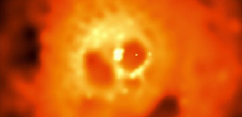
 04/24/2014
04/24/2014
Resonantly Produced 7 keV Sterile Neutrino Dark Matter Models and the Properties of Milky Way Satellites
Kevork N. Abazajian
Phys. Rev. Lett. 112, 161303 (2014)
Published April 24, 2014
Cosmologists have long considered neutrinos as possible dark matter particles. However, because of their small mass (less than about 1 eV), conventional neutrinos are too fast, or “hot,” to form the dense dark matter structures needed to hold galaxies and galaxy clusters together. By contrast, sterile neutrinos, which result from certain neutrino theories, can have larger masses and could have been naturally produced in the big bang by neutrino flavor mixing.
The problem has been that sterile neutrinos should decay, producing an x-ray signal that no one has observed—until maybe now. Earlier in 2014, an analysis of galaxy cluster data revealed an x-ray emission line, which is consistent with the decay of a 7-keV sterile neutrino. Normally, dark matter with this mass would be too “warm” to match galaxy data. However, Abazajian showed that the sterile neutrinos could have a “cooler” momentum distribution if they were produced through resonantly enhanced neutrino flavor mixing (the MSW effect). When Abazajian plugged this neutrino into a cosmological model, he found it could explain both the small number of Milky Way satellite galaxies and their central densities, which have eluded the currently favored cold dark matter model.
Phys. Rev. Lett. 112, 161303 (2014)
